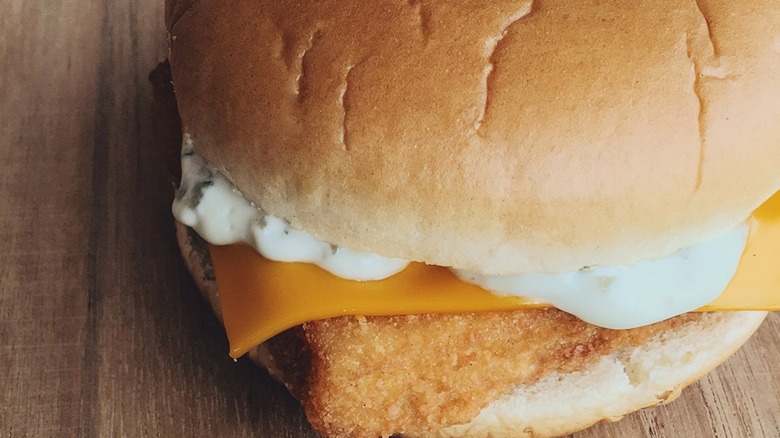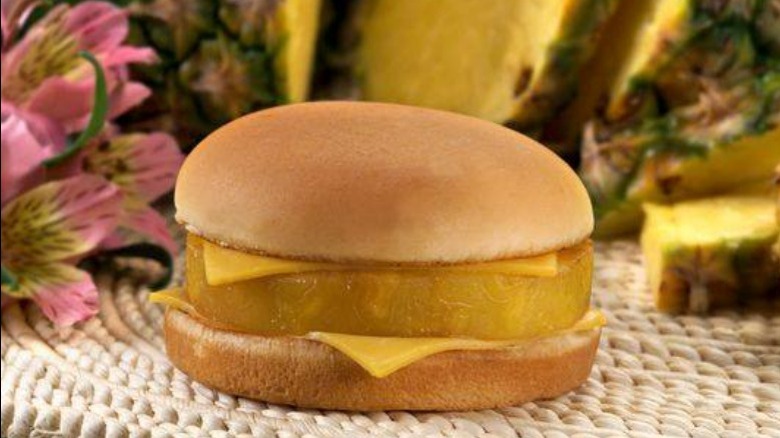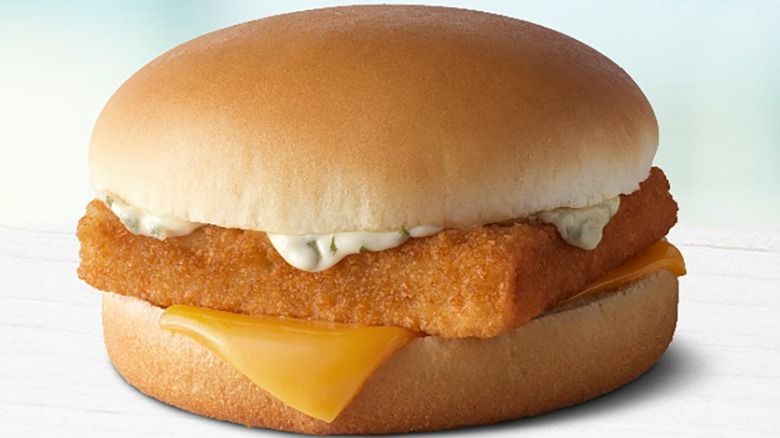The Rise And Immediate Fall Of McDonald's 'Hula Burger'
McDonald's has more than a few recognizable burgers on its menu. Just a few of these names include the classic Big Mac, the Quarter Pounder, and even something so simple as a McDouble. But there's one sandwich on the menu that technically isn't a "burger" in the same sense that a Quarter Pounder and Big Mac are: the Filet-O-Fish.
For those who may be out of the loop, McDonald's tells us that its Filet-O-Fish is made from "wild-caught Alaska Pollock" and topped with American cheese and tartar sauce between two steamed buns. The sandwich, while admittedly seeming a bit out of place in a restaurant known for hamburgers and French fries, has actually garnered an impressive fanbase. Canadian Business estimated in 2014 that over 300 million Filet-O-Fish sandwiches are sold each year, while The New York Times praised the fish sandwich as a "gold standard of fast food," noting its popularity with Asian Americans. Even former President Donald Trump voiced his approval of it!
But wait a second, you may be asking, aren't we supposed to be talking about the "Hula Burger?" Why are we sitting here talking about the Filet-O-Fish? It may come as a surprise, but McDonald's famous fish sandwich and the somewhat obscure Hula Burger were actually going to be one and the same — at least, in theory. The story of the Hula Burger and the Filet-O-Fish is one of Catholics, pineapples, and a bet between McDonald's CEO and a franchisee in Cincinnati.
The Filet-O-Fish beat out a pineapple sandwich
If you're a practicing Catholic, you know that the Lenten season usually happens around the Easter holiday. During the time of Lent, the practice of eating meats like beef, pork, and chicken is forbidden. Fish, however, is deemed okay to eat. While that may bode well for seafood and pizza restaurants, restaurants that specialize in beef and chicken may find themselves struggling to appeal to meat-abstaining Catholics.
This was the case, Smithsonian Magazine tells us, for Lou Groen, a McDonald's franchisee in Ohio in the 1960s. Groen's restaurant was struggling at the time, especially during Lent, as most customers avoided the hamburgers Groen was selling. Groen knew that, if he wanted to keep his McDonald's afloat, he would have to invent something to appeal to the Catholic masses. His idea? A breaded fish sandwich. Groen decided to take his idea all the way to the top, right up to head honcho Ray Kroc. Kroc, however, dismissed Groen's idea at first, sneering that he didn't want his restaurants to smell like fish. Kroc instead made Groen a proposal: If Groen's fish sandwich could beat out Kroc's own "Hula Burger" in sales, he promised to make Groen's sandwich permanent on the menu.
As Reader's Digest tells us, Kroc's "Hula Burger" was nothing more than a pineapple ring between two buns. When one McDonald's store began to sell Hula Burgers and Filet-O-Fish, over 350 customers purchased the Filet-O-Fish, leaving the fruit and bread sandwich floundering behind.
The Filet-O-Fish and the Hula Burger today
It would seem that Groen's Filet-O-Fish beat out Kroc's Hula Burger — obvious by the fact no one has ever walked into a McDonald's and eaten a piece of pineapple sandwiched between white bread for lunch. But if the Filet-O-Fish was designed to attract practicing Catholics, how exactly does the sandwich still hold up today in that respect?
According to a 2019 article from USA Today, McDonald's reported that, during the Lenten season, it sells 25% of its Filet-O-Fish. In 2017, Insider reported that the Filet-O-Fish typically becomes McDonald's most popular item during March, a month that coincidentally enough is also the start of the Lenten season. Perhaps taking from example, other fast-food companies like Arby's and Chick-fil-A have also introduced fish sandwiches to their menu — with Arby's even going so far as to call McDonald's out on its Filet-O-Fish (via Seafood Source).
As for the Hula Burger, the pineapple-based sandwich has become something of a relic in the halls of McDonald's blunders and mistakes (via Reader's Digest). While adding a ring of pineapple to a burger today may sound like something McDonald's would do, the Hula Burger may not have been what the Catholic customer had in mind.


